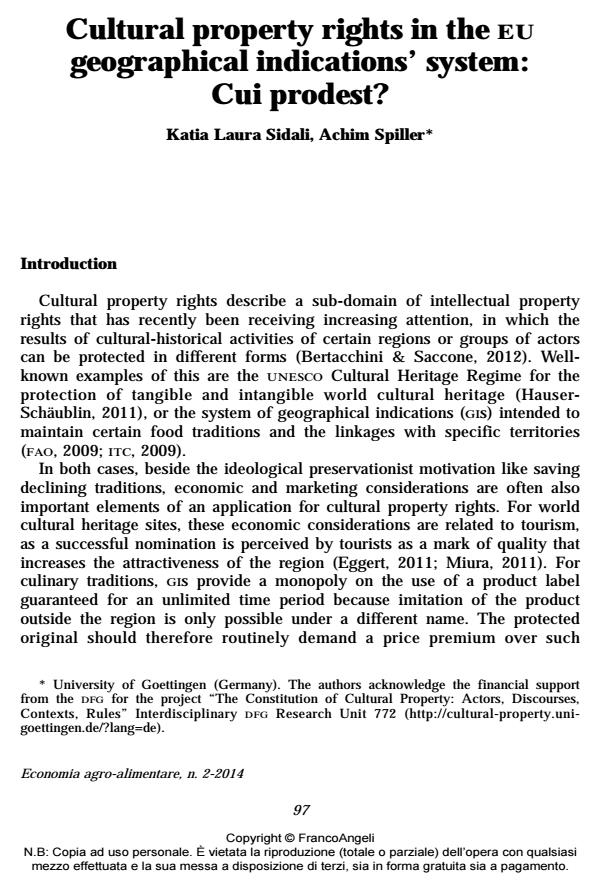Cultural property rights in the eu geographical indications’ system: Cui prodest?
Journal title ECONOMIA AGRO-ALIMENTARE
Author/s Katia Laura Sidali, Achim Spiller
Publishing Year 2014 Issue 2014/2 Language English
Pages 8 P. 97-104 File size 44 KB
DOI 10.3280/ECAG2014-002006
DOI is like a bar code for intellectual property: to have more infomation
click here
Below, you can see the article first page
If you want to buy this article in PDF format, you can do it, following the instructions to buy download credits

FrancoAngeli is member of Publishers International Linking Association, Inc (PILA), a not-for-profit association which run the CrossRef service enabling links to and from online scholarly content.
This paper develops five theses to analyze the distribution of economic, social and environmental effects connected with the system of geographical indications (gis). The authors claim that the distribution of benefits for the agricultural sector largely differentiate among European countries (Thesis 1); non-organized outsiders in the region who do not financially support the common pool resource can profit particularly greatly from a gis system (Thesis 2); among gis consortia, those with a clear marketing leadership of a focal supplier profit whereas those with many small suppliers are easier to get pressed by dominant buyers (Thesis 3); the role of public authorities may represent a significant bias in the application phase (Thesis 4) and environmental benefits attached to the gis such as biodiversity preservation are largely overestimated (Thesis 5).
Keywords: Cultural property rights, eu system of geographical indications, pdo, pgi
Jel codes: D23, D18, D21, M31, P14
- Arfini, F., Belletti, G., & Marescotti, A. (2010). Prodotti tipici e denominazioni geografiche. Strumenti di tutela e valorizzazione. Quaderni. www.gruppo2013.it/quaderni/Pagine/default.aspx.
- Becker, T. (2005). Zur Bedeutung geschützter Herkunftsangaben. Hohenheimer Agrarökonomische Arbeitsberichte, n. 12, Stuttgart, 2005.
- Bertacchini, E., & Saccone, D. (2012). Toward a political economy of World Heritage. Journal of Cultural Economics, Online First Publication. DOI: 10.1007/s10824-012-9169-3
- Casari, M. (2007). Emergence of endogenous legal institutions: property rights and community governance in the Italian Alps. Journal of Economic History, 67(1), 191-226. DOI: 10.1017/S0022050707000071
- Eggert, A. (2011). A Cambodian “Leitkultur”?: Cambodian concepts of art and culture, 69-96.
- European Court of Auditors (2011). Do the design and management of the geographical indications scheme allow it to be effective? Special report n. 11. European Court of Auditors, Luxembourg.
- Fao (2009). Linking people, places and products. A guide for promoting quality linked to geographical origin and sustainable Geographical Indications. In: E. Vandecandelaere, F. Arfini, G. Belletti & A. Marescotti (Eds.).
- Hassan, D., & Monier-Dilhan, S. (2002). Signes de qualitè; et qualitè des signes: une application au marchè du camembert. Ivry, France: Institut national de la rechercheagronomique.
- Hauser-Schäublin, B. (2011). World Heritage Angkor and beyond. Circumstances and implications of unesco listings in Cambodia. Göttingen: Univ.-Verl.
- ITC (2009). Guide to Geographical Indications: Linking Products and Their Origins. In: D. Giovannucci, T. Josling, W. Kerr, B. O’Connor & M.T. Yeung (Eds.).
- Joguet, V. (2010). Indications géographiques: qualité des produits, environnement et cultures: Agence Francaise de Développement & FondsFrancais pour l’Environnement Mondial www.afd.fr/jahia/webdav/site/afd/shared/PUB LICATIONS/THEMATIQUES/savoirscommuns/09-Savoirs-co mmuns.pdf.
- Miura, K. (2011). World heritage making in Angkor. Global, regional, national and local actors, interplays and implications, 9-32.
- Profeta, A. & Balling R. (2007). Evaluierung der Übergangsregelung des Herkunftsschutzes bei Agrarprodukten und Lebensmitteln in Europa gemäß Verordnung (eg) n. 510/06 und Verbesserungsvorschläge für die anstehende Modifikation. Agrarwirtschaft, 56(4), 213- 222.
- Profeta, A., Balling, R., Schoene, V., & Wirsig, A. (2009). The Protection of Origins for Agricultural Products and Foods in Europe: Status Quo, Problems and Policy Recommendations for the Green Book. The Journal of World Intellectual Property, 12(6), 622-648. DOI: 10.1111/j.1747-1796.2009.00380.x
- Thual, D., & Lossy, F. (2011). Q&A Manual European Legislation on Geographical Indications: IPR2. http://ipr2.org/document-centre/list.php?id=25.
- Legal references
- Council Regulation (ec) n. 510/2006 of 20 March 2006 on the protection of geographical indications and designations of origin for agricultural products and foodstuffs.
- Law n. 201 of 22nd December 2008 of the Italian government for the conversion of decree-lay n. 162 of 23rd October 2008 into law.
- Regulation (eu) n. 261/2012 of the European Parliament and of the Council of 14 March 2012 amending Council Regulation (ec) n. 1234/2007 as regards contractual relations in the milk and milk products sector. http://eur-lex.europa.eu/LexUriServ/LexUriServ.do?uri=CELEX:32012R0261:en:NOT.
- Regulation (eu) n. 1151/2012 of the European Parliament and of the Council of 21 November 2012 on quality schemes for agricultural products and foodstuffs.
- New trends in the debate on geographical indications: evidence from Ecuador Katia L. Sidali, Nelson R. Granja Toledo, Alvaro Monteros Altamirano, Mirian Sanchez Fernandez, Maria del Rosario Mejía, Wilson Usina, in ECONOMIA AGRO-ALIMENTARE 1/2016 pp.39
DOI: 10.3280/ECAG2016-001003 - Salsa, sauce, and other ingredients: nature, evolution and conservation of cultural heritage Edgardo I. Garrido-Pérez, Katia Laura Sidali, in ECONOMIA AGRO-ALIMENTARE 3/2014 pp.81
DOI: 10.3280/ECAG2014-003007
Katia Laura Sidali, Achim Spiller, Cultural property rights in the eu geographical indications’ system: Cui prodest? in "ECONOMIA AGRO-ALIMENTARE" 2/2014, pp 97-104, DOI: 10.3280/ECAG2014-002006